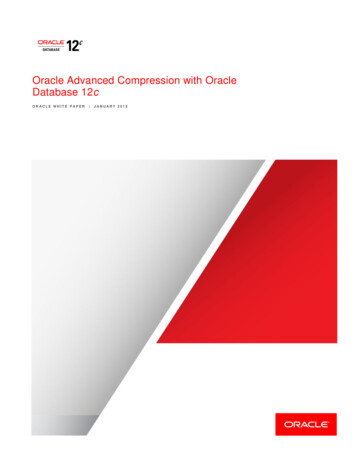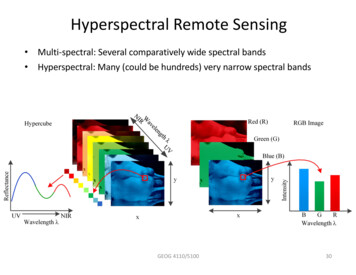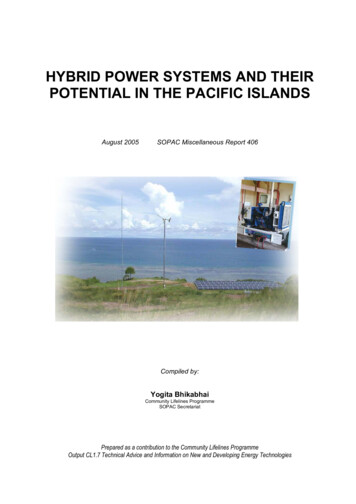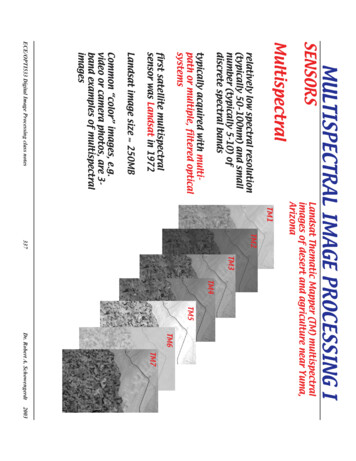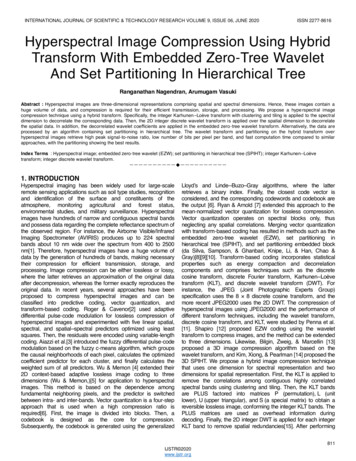
Transcription
INTERNATIONAL JOURNAL OF SCIENTIFIC & TECHNOLOGY RESEARCH VOLUME 9, ISSUE 06, JUNE 2020ISSN 2277-8616Hyperspectral Image Compression Using HybridTransform With Embedded Zero-Tree WaveletAnd Set Partitioning In Hierarchical TreeRanganathan Nagendran, Arumugam VasukiAbstract : Hyperspectral images are three-dimensional representations comprising spatial and spectral dimensions. Hence, these images contain ahuge volume of data, and compression is required for their efficient transmission, storage, and processing. We propose a hyperspectral imagecompression technique using a hybrid transform. Specifically, the integer Karhunen–Loève transform with clustering and tiling is applied to the spectraldimension to decorrelate the corresponding data. Then, the 2D integer discrete wavelet transform is applied over the spatial dimension to decorrelatethe spatial data. In addition, the decorrelated wavelet coefficients are applied in the embedded zero-tree wavelet transform. Alternatively, the data areprocessed by an algorithm containing set partitioning in hierarchical tree. The wavelet transform and partitioning on the hybrid transform overhyperspectral images retrieve high peak signal-to-noise ratio, low number of bits per pixel per band, and fast computation time compared to similarapproaches, with the partitioning showing the best results.Index Terms : Hyperspectral image; embedded zero-tree wavelet (EZW); set partitioning in hierarchical tree (SPIHT); integer Karhunen–Loèvetransform; integer discrete wavelet transform.—————————— ——————————1. INTRODUCTIONHyperspectral imaging has been widely used for large-scaleremote sensing applications such as soil type studies, recognitionand identification of the surface and constituents of theatmosphere, monitoring agricultural and forest status,environmental studies, and military surveillance. Hyperspectralimages have hundreds of narrow and contiguous spectral bandsand possess data regarding the complete reflectance spectrum ofthe observed region. For instance, the Airborne Visible/InfraredImaging Spectrometer (AVIRIS) produces up to 224 spectralbands about 10 nm wide over the spectrum from 400 to 2500nm[1]. Therefore, hyperspectral images have a huge volume ofdata by the generation of hundreds of bands, making necessarytheir compression for efficient transmission, storage, andprocessing. Image compression can be either lossless or lossy,where the latter retrieves an approximation of the original dataafter decompression, whereas the former exactly reproduces theoriginal data. In recent years, several approaches have beenproposed to compress hyperspectral images and can beclassified into predictive coding, vector quantization, andtransform-based coding. Roger & Cavenor[2] used adaptivedifferential pulse-code modulation for lossless compression ofhyperspectral images and experimented with five linear spatial,spectral, and spatial–spectral predictors optimized using leastsquares. Then, the residuals were encoded using variable-lengthcoding. Aiazzi et al.[3] introduced the fuzzy differential pulse-codemodulation based on the fuzzy c-means algorithm, which groupsthe causal neighborhoods of each pixel, calculates the optimizedcoefficient predictor for each cluster, and finally calculates theweighted sum of all predictors. Wu & Memon [4] extended their2D context-based adaptive lossless image coding to threedimensions (Wu & Memon,)[5] for application to hyperspectralimages. This method is based on the dependence amongfundamental neighboring pixels, and the predictor is switchedbetween intra- and inter-bands. Vector quantization is a four-stepapproach that is used when a high compression ratio isrequired[6]. First, the image is divided into blocks. Then, acodebook is designed as the core for compression.Subsequently, the codebook is generated using the generalizedLloyd’s and Linde–Buzo–Gray algorithms, where the latterretrieves a binary index. Finally, the closest code vector isconsidered, and the corresponding codewords and codebook arethe output [6]. Ryan & Arnold [7] extended this approach to themean-normalized vector quantization for lossless compression.Vector quantization operates on spectral blocks only, thusneglecting any spatial correlations. Merging vector quantizationwith transform-based coding has resulted in methods such as theembedded zero-tree wavelet (EZW), set partitioning inhierarchical tree (SPIHT), and set partitioning embedded block(da Silva, Sampson, & Ghanbari, Knipe, Li, & Han, Chao &Gray)[8][9][10]. Transform-based coding incorporates statisticalproperties such as energy compaction and decorrelationcomponents and comprises techniques such as the discretecosine transform, discrete Fourier transform, Karhunen–Loèvetransform (KLT), and discrete wavelet transform (DWT). Forinstance, the JPEG (Joint Photographic Experts Group)specification uses the 8 8 discrete cosine transform, and themore recent JPEG2000 uses the 2D DWT. The compression ofhyperspectral images using JPEG2000 and the performance ofdifferent transform techniques, including the wavelet transform,discrete cosine transform, and KLT, were studied by Penna et al.[11]. Shapiro [12] proposed EZW coding using the wavelettransform to compress images, and the method can be extendedto three dimensions. Likewise, Bilgin, Zweig, & Marcellin [13]proposed a 3D image compression algorithm based on thewavelet transform, and Kim, Xiong, & Pearlman [14] proposed the3D SPIHT. We propose a hybrid image compression techniquethat uses one dimension for spectral representation and twodimensions for spatial representation. First, the KLT is applied toremove the correlations among contiguous highly correlatedspectral bands using clustering and tiling. Then, the KLT bandsare PLUS factored into matrices P (permutation), L (unitlower), U (upper triangular), and S (a special matrix) to obtain areversible lossless image, conforming the integer KLT bands. ThePLUS matrices are used as overhead information duringdecoding. Finally, the 2D integer DWT is applied for each integerKLT band to remove spatial redundancies[15]. After performing811IJSTR 2020www.ijstr.org
INTERNATIONAL JOURNAL OF SCIENTIFIC & TECHNOLOGY RESEARCH VOLUME 9, ISSUE 06, JUNE 2020the hybrid transform, either the EZW or SPIHT algorithm areapplied to encode the transformed hyperspectral images aimingfor performance evaluation. Figures 1 shows the block diagram ofthe proposed hybrid-transform-based image compression, andFigure 2 illustrates a pixel vector of a hyperspectral image. In thesequel, we detail the integer KLT and 2D integer DWT. Then, weintroduce the EZW algorithm for hyperspectral images and detailthe SPIHT algorithm. Experimental results verify the effectivenessof the proposed hybrid transform to compress hyperspectralimages.ISSN 2277-8616decomposition of 𝐗 𝐀𝚲𝐀 , where Λ is diagonal matrixdiag( 𝜆 , 𝜆 , , 𝜆 ) with 𝜆 𝜆 𝜆 .Spectral decorrelation proceeds as follows, with input beinghyperspectral image X as a matrix of dimension Z M2:The corresponding band mean is subtracted from every entry inX:𝐗 [ 𝑥 , 𝑚𝑒𝑎𝑛 ](2)where 0 𝑧 𝑍 1; 0 𝑚 𝑀 1. The mean is alsorequired for decoding.Covariance matrix C of Xadjust is determined. Equation (3)shows the covariance between bands A and B, where 𝑥,and 𝑥,are individual values from bands A and B,respectively, whereas 𝜇 and 𝜇 are the mean values of bands Aand B from Xadjust, respectively. Covariance matrix C is a Z Zsquare matrix (Equation (4)) containing the variance of the bandsalong the diagonal. Band numbers are denoted with subscripts bin the matrix.(𝑐𝑜𝑣(𝐴, 𝐵) Figure 1. Block diagram of proposed hybrid-transform-basedhyperspectral image compression.,)(),(3)where 0 𝑚 𝑀 1.𝑐𝑜𝑣𝑐𝑜𝑣𝐂 [ 𝑐𝑜𝑣 ,,,𝑐𝑜𝑣 ,𝑐𝑜𝑣 , 𝑐𝑜𝑣 , 𝑐𝑜𝑣 𝑐𝑜𝑣 𝑐𝑜𝑣,,],(4)Figure 2. Diagram of pixel vector in a hyperspectral image.2. KLT2.1 Conventional KLTThe KLT algorithm provides lossy data compression for anoptimal block-based transform in a statistical sense (Penna etal.)[16] and is similar to principal component analysis(Gerbrands)[17]. The conventional KLT provides highdecorrelation and can be applied over the spectral dimension toremove redundancy of data in hyperspectral images. Let Xdenote a hyperspectral image with spatial dimension of size M M and Z bands in the spectral dimension. Image X is arranged asa matrix with Z rows and M2 columns. A mean-centered functionis computed by finding the difference between each band and X.Blanes & Serra-Sagristà [18] compute X in the KLT as𝐗 𝐊𝐋𝐓 𝐗 (𝐗) 𝐀 𝐗(1)where Xencoded is the hyperspectral image accompanied by thecentered mean, 𝐗 ( 1 𝑀 &) 𝐗𝐗 is the covariance matrix ofX, A is the orthogonal matrix acquired from the singular valueThe singular value decomposition is applied to C to obtain theeigenvectors as matrix A and the eigenvalues as vector v𝛼 ,𝛼 𝛼,𝛼,𝛼, 𝛼,𝐀 [ 𝒗 ] 𝛼 , 𝛼 , 𝛼 ,,vv(5)[ ]vEvery row in A is a principal component. Then, every eigenvectorin A is sorted in descending order according to the eigenvalues inv, thus obtaining:𝑎,𝑎 𝑎,𝑎,𝑎, 𝑎,𝐀 [ ]𝑎 , 𝑎 , 𝑎 ,(6)with Z vectors of principal components. This matrix is called theKLT transform matrix.KLT transform matrix A is multiplied with Xadjust to obtain theencoded hyperspectral image:𝐗 (𝑎 , ) 𝑥(7),where 0 𝑖 𝑍 1; 0 𝑚 𝑀 1.For lossy compression, number P Z of principal components inKLT transform matrix A corresponding to the largest eigenvaluesin v results in a submatrix with dimension P Z of A, beingequivalent to principal component analysis. On the other hand,when all the principal components are preserved (i.e., A hasdimension Z Z), the transform coding corresponds to the KLT812IJSTR 2020www.ijstr.org
INTERNATIONAL JOURNAL OF SCIENTIFIC & TECHNOLOGY RESEARCH VOLUME 9, ISSUE 06, JUNE 2020[19]. Square matrix A is nonsingular (i.e., invertible) and isrequired along with the mean for decoding, because the latter isconsidered as overhead information. Equations (8) and (9)describe the KLT decoding for spectral components and themean restoration, respectively.𝐗 𝑎, 𝑥(8),where 0 𝑖 𝑍 1; 0 𝑚 𝑀 1.𝐗 [𝑋 , 𝑚𝑒𝑎𝑛 ](9)where 0 𝑧 𝑍 1; 0 𝑚 𝑀 1.2.2 Integer KLTAn approximation of the KLT has been proposed by Hao &Shi[20] using matrix factorization of matrix 𝐀 , which was derivedin (Hao & Shi)[21], representing encoded image Xencoded as aninteger matrix, conforming the integer KLT, which differs from theconventional KLT in the following steps:(1) The band mean is rounded for step 1.The KLT transform matrix or eigenvector matrix, 𝐀 , is factoredinto matrices, P, L, U, and S in step 3.The PLUS matrices are applied to Xadjust using reversible liftingoperations.2.3 Eigenvector matrix factorizationThe matrix factorization method presented by Hao & Shi [21,22]is also considered as an integer-to-integer transform, because ituses integer mapping to generate an integer output. The integerKLT is implemented based on matrix factorization applied toeigenvector matrix AT, which is obtained as the product ofelementary reversible matrices (ERMs), whose diagonalelements are equal to 1. An ERM that has unit diagonalelements is called unit triangular ERM. A triangular ERM [22] issimilar to the LU (lower–upper) factorization (Turing)[23]. Thefactorization is applied to eigenvector matrix 𝐴 𝑇 , which isnonsingular and composed of four Z Z matrices, namely,reversible permutation matrix P, lower triangular ERMs L and S,and upper triangular ERM U, thus conforming a PLUSfactorization.2.4 Computational complexity reductionIn the KLT with clustering and tiling illustrated in Figure 3, each1D spectral vector is converted into a 2D matrix, whose partialcovariance matrix can be directly determined. Then, thecovariance matrices are accumulated for eigen-decompositionand data projection. This way, each row of the matrix contains agroup of W bands, where the Z bands are clustered into H groupsor segments. When H 1, the KLT with clustering and tilingdegrades to the conventional KLT, whereas when H Z, nogrouping of bands occurs. The performance of KLT withclustering and tiling depends on the selection of H, as it affectsthe additional information that can be extracted with respect to theconventional KLT [24].HZISSN 2277-8616Figure 3. Construction of 2D matrix by clustering and tiling 1Dspectral vector.Considering the high redundancy between spectral bands, bandclustering is used for band selection and feature characterization[25][26]. From this 2D matrix-based representation, thecorresponding covariance matrix helps to extract not only theglobal structure but also local structures, and hence this approachis superior in performance compared to the conventional KLT(Pang et al., Yu, Bi, & Ye,)[27][28]. In fact, a better discriminationcapability with less computational cost and memory requirementsis achieved depending on the value of H, as it determines thespectral vector clustering and tiling in a process also known asfolded principal component analysis (Zabalza et al.,)[24].𝑃 𝑃 ] , let 𝐀 be theFor a spectral vector 𝑷 [ 𝑃transformed matrix of size H W (HW Z). Let𝑎𝑎𝐀 [ ]𝑎𝑎 [𝑷 (1 𝑊(ℎ 1)) 𝑷 (2 𝑊 (ℎ 1) )) 𝑷 (𝑊 𝑊 (ℎ 1))](10)where ℎ [1, 𝐻]. The covariance matrix of 𝐀 is calculated as𝐂 𝐀 𝐀 ,𝐂 ℝ(11)Then, the overall covariance matrix for the resulting hypercube isdetermined as the accumulation of the partial covariancematrices:𝐂 𝐂 𝐀 𝐀(12)where S represents the spatial size of the hypercube. Then, theconventional KLT can be applied for eigen-decomposition with thereduced size, W W, of 𝐶, whereas the covariance matrixfrom the conventional KLT has size Z Z, thus representing anotably reduced computational cost. Regarding data projection,the equations in the conventional KLT should be adjusted tomanage with the input in the clustered vector, i.e., matrix𝐴 ℝrather than spectral vector Pn, For covariancematrix 𝐂, let q’ be the number of selected eigenvalues andΛ ℝthe matrix formed using the eigenvectors for dataprojection. For each row vector in 𝐀 , q’ components areextracted during multiplication with Λ, which results in 𝑞 𝐻𝑞features for the whole image. The data acquired from projection,𝐙 ℝ, is determined by multiplying two smaller matrices:𝐙 𝐀 𝚲, 𝐀 ℝ,𝚲 ℝwhich also considerably reduces the computational cost (Zabalzaet al., 2014).3. Integer DWTThe lifting scheme was proposed by Daubechies & Sweldens [29]to simplify the implementation of the discrete wavelet transformby considering stages of split, prediction, and update: Split (lazywavelet transform): Input discrete signal x[n] is divided into oddand even samples: s0[n] x[2n] and d0[n] x[2n 1]. Eachgroup contains one half of the samples from the input signal. Thisprocess is known as lazy wavelet transform. Prediction: Theeven and odd signal samples are interleaved. If the signalpresents local correlations, some of the nearest neighbors can beused to predict samples. In the integer DWT, even samples areused to predict the odd ones. Then, the difference between theprediction and actual odd sample is calculated. Prediction allowsW813IJSTR 2020www.ijstr.org
INTERNATIONAL JOURNAL OF SCIENTIFIC & TECHNOLOGY RESEARCH VOLUME 9, ISSUE 06, JUNE 2020to considerably compress data. Update: At this stage, the globalproperties of the original signal are preserved, as signals at thehighest-level sub-band have a similar average as the originalsignal. Each even sample is substituted by the average.Prediction and update can be expressed as𝑠 [𝑛] 𝑠 [𝑛] 𝑢 [𝑘]𝑑 [𝑛 𝑘]𝑑 [𝑛] 𝑑 [𝑛] 𝑝 [𝑘]𝑠 [𝑛𝑘](13)(14)where 𝑠 [𝑛] and 𝑑 [𝑛] are the outputs of the j-th pair of predictionand update, 𝑝 [𝑘] and 𝑢 [𝑘] are parameters of prediction andupdate, respectively, which are computed by factorizing theresultant matrix obtained through the integer KLT. Figure 4illustrates the lifting scheme with m pairs of predictions andupdates.Sm[nS]S1[n]S0[n /kX[SplP1-U1PmUmk-d0[n]d1[n]dm[n]dFigure 4. Diagram of forward wavelet transform for liftingscheme. (Pi, i-th prediction step; Ui, i-th update step)For hyperspectral images, we implement the 2D integer DWToptimized by the lifting scheme instead of the 3D DWT in thespatial dimension. The lifting scheme reduces the computationalcomplexity and retrieves the output as a reversible integerwavelet transform (Jensen & la Cour-Harbo)[30]. Wedecomposed the 3D hyperspectral image per band using the 2Ddyadic wavelet. Figure 5 illustrates the second-leveldecomposition on each band. The integer DWT has twoimportant properties which are essential for image compression,namely, energy packing and self-similarity.ISSN 2277-8616Figure 5. Three-dimensional integer wavelet transform stored ina data cube.We evaluated the transform-based coding illustrated in Figure 1using two techniques, namely, EZW and SPIHT. Therefore, weobtained the hybrid transform with EZW and the hybrid transformwith SPIHT, as detailed below.4. EZWShapiro introduced the EZW algorithm that exploits theadvantages of the wavelet transform[12]. The algorithmrepresents a progressive and embedded image coding methodbased on the zero-tree data structure, and its most remarkablecharacteristic is the existence of wavelet coefficients in differentsub-bands that represent the same spatial location in an image.By energy packing, the wavelet coefficients in the higher-levelsub-bands are processed before those in the lower-level subbands using the Morton scan order. The quadtree decompositionof the EZW algorithm has two passes, namely, dominant andsubordinate passes. The dominant pass keeps track of thesearch for the significant coefficients, which have four possiblelabels: significant positive, significant negative, zero-tree root, andisolated zero. The subordinate pass quantizes each significantcoefficient that is found during the dominant pass. If the absolutevalue of a root coefficient is larger than a threshold, it is labeled aseither significant positive or significant negative. Hence, some ofthe descendants of the coefficients are significant. An isolatedzero is a root coefficient that is insignificant but has somesignificant descendants. If the coefficient is a zero-tree root, theroot coefficient itself and its descendants are all insignificant, andthus these descendants need not be encoded at the currentiteration (Cheng & Dill)[15]. The transform-based codingillustrated in Figure 1 can be achieved by using either EZW aloneor the proposed hybrid transform with EZW.5. SPIHTThe SPIHT algorithm proposed by Said & Pearlman [31]generalizes the EZW algorithm and uses tree partitioning, whichtends to maintain insignificant coefficients together in largesubsets. The trees are further partitioned into four types of sets,which are termed the set of coordinates of the coefficients:O(i,j): set of coordinates of the offspring of wavelet coefficients atlocation (i,j).D(i,j): set of all descendants of the coefficients at location (i,j).G: set of root nodes.L(i,j): set of coordinates of all the descendants of the coefficient atlocation (i,j), except for immediate offspring at this location.SPIHT can be used as an alternate transform-based codingmechanism, and as with EZW, we also established a hybridtransform with SPIHT for processing the hyperspectral images.6. Experimental ResultsWe considered test hyperspectral images acquired using AVIRISfor evaluation of the proposed compression method over theregions of Indian Pines, Salinas, Botswana, Urban, and KSC(Hyperspectral remote sensing scenes; Sun: Hyperspectraldatasets)[32][33]. We cropped the images to 128 128 128from the top-left corner. The evaluation was implemented onMATLAB (Mathworks, Inc., Natick, MA, USA) and executed on acomputer with Intel( R) Core(TM) i3-3217U @ 1.80 GHz814IJSTR 2020www.ijstr.org
INTERNATIONAL JOURNAL OF SCIENTIFIC & TECHNOLOGY RESEARCH VOLUME 9, ISSUE 06, JUNE 2020ISSN 2277-8616processor and 6 GB RAM. We applied different wavelet filters to ratio (PSNR, expressed in decibels) when applying the EZWthe images, including Haar wavelets, Daubechies wavelets (db1 algorithm, the SPIHT algorithm, the hybrid transform with EZWand db4), Symlets (sym6), and biorthogonal wavelets (Bior2.4 algorithm, and the hybrid transform with SPIHT algorithm,and Bior4.4). We compared the results using these filters and the respectively. Table 5 lists the computation time in seconds for theEZW and SPIHT algorithms, the proposed hybrid transform with compared techniques when applied on hyperspectral images.EZW, and the proposed hybrid transform with SPIHT. Tables 1 to4 list the compression results using the different wavelet filters interms of bits per pixel per band (bpppb) and peak signal-to-noiseTABLE 1. COMPRESSION RESULTS FROM EZW ALGORITHM USING VARIOUS WAVELET FILTERS.Compression PerformanceHyperspectral imagesIndian 1.7250.707.5148.336.99TABLE 2. COMPRESSION RESULTS FROM SPIHT ALGORITHM USING VARIOUS WAVELET FILTERS.Compression PerformanceHyperspectralIndian .83Bior4.4TABLE 3. COMPRESSION RESULTS FROM HYBRID TRANSFORM WITH EZW ALGORITHM FOR VARIOUS WAVELET FILTERS.Compression PerformanceHyperspectral imagesIndian .667.27Bior4.4815IJSTR 2020www.ijstr.org
INTERNATIONAL JOURNAL OF SCIENTIFIC & TECHNOLOGY RESEARCH VOLUME 9, ISSUE 06, JUNE 2020ISSN 2277-8616TABLE 4. COMPRESSION RESULTS FROM HYBRID TRANSFORM WITH SPIHT ALGORITHM FOR VARIOUS WAVELET FILTERS.Compression PerformanceHyperspectral ImagesWavelet filterIndian 19.0756.086.5457.177.9248.445.8246.664.97TABLE 5. COMPUTATION TIME IN SECONDS OF EVALUATED TECHNIQUES TO COMPRESS HYPERSPECTRAL IMAGES.Indian T18319518598142Hybrid transform w/EZW465242365169187Hybrid transform w/SPIHT14313911890102Figure 6. Original hyperspectral images from different regions.The PSNR for the all the tested images using the hybridtransforms are high, and the bits per pixel per band are betterthan the other comparison approaches. In Tables 1 and 2, theBior2.4 wavelet filter retrieves the highest PSNR and lowestnumber of bits per pixel per band among the evaluated filters.Likewise, in Tables 3 and 4, both the Bior2.4 and Haar waveletfilters retrieve the best results. The proposed hybrid transformwith both the EZW and SPIHT algorithms retrieves better resultsthan the corresponding conventional algorithms for all the testhyperspectral images. In addition, the hyperspectral images romSalinas, Urban, and KSC are more influenced by the evaluatedalgorithms than those from Indian Pines and Botswana. FromTable 5, the computation time using the hybrid transform withEZW and SPIHT algorithms is lower than that of thecorresponding conventional algorithms for all test images. Theseresults suggest that the hybrid transform with SPIHT algorithmprovides the best performance than the other approaches. Figure6 shows original hyperspectral images from the evaluatedregions, and Figures 7 to 10 show reconstructed images usingthe four evaluated approaches applied to these hyperspectralimages using the Bior2.4 wavelet filter at the 128th band. All thereconstructed images are very similar to the original images. Infact, the reconstructed images retrieved a very low mean squarederror.816IJSTR 2020www.ijstr.org
INTERNATIONAL JOURNAL OF SCIENTIFIC & TECHNOLOGY RESEARCH VOLUME 9, ISSUE 06, JUNE 2020Indian PinesIndian PinesSalinasSalinasBotswanaUrbanBotswanaISSN 2277-8616KSCUrbanKSCFigure 7. Reconstructed images using EZW compression with Bior2.4 wavelet filter at the 128th band.Indian PinesSalinasBotswanaUrbanKSCFigure 8. Reconstructed images using SPIHT compression with Bior2.4 wavelet filter at the 128th band.Indian PinesSalinasBotswanaUrbanKSCFigure 9. Reconstructed images using hybrid-transform compression with EZW and Bior2.4 wavelet filter at the 128th band.Indian PinesSalinasBotswanaUrbanKSC817IJSTR 2020www.ijstr.org
INTERNATIONAL JOURNAL OF SCIENTIFIC & TECHNOLOGY RESEARCH VOLUME 9, ISSUE 06, JUNE 2020ISSN 2277-8616Figure 10. Reconstructed images using hybrid-transform compression with SPIHT and Bior2.4 wavelet filter at the 128th band.7. CONCLUSIONWe propose hybrid transforms for compressing hyperspectralimages using either the EZW or SPIHT algorithm. We evaluatedthe compression performance on hyperspectral images, and thehybrid transform with SPIHT algorithm retrieved betterperformance results in terms of PSNR, bits per pixel per band,and computation time than the transform with the EZW algorithmand the conventional SPIHT and EZW algorithms. Moreover, theunderlying KLT with clustering and tiling reduces thecomputational complexity of hyperspectral images. The obtainedcompression was between 3.79 and 12.99 bits per pixel per bandfor the hyperspectral images.REFERENCES[1] AVIRIS—Airborne Visible/Infrared Imaging Spectrometer(https://aviris.jpl.nasa.gov/).[2] Roger, R.E., & Cavenor, M.C, “Lossless compression of AVIRISimages,” IEEE Transactions on Image Processing, 5(5), 713–719, 1996, doi: 10.1109/83.495955[3] Aiazzi, B, Alba, P., Alparone, L., & Baronti, S, “Losslesscompression of multi/hyper-spectral imagery based on a 3-Dfuzzy prediction,” IEEE Transactions on Geoscience 9/36.789625[4] Wu, X., & Memon, N, “Context-based, adaptive, lossless imagecoding,” IEEE Transactions on Communications, 45(4), 437–444. 1997, doi: 10.1109/26.585919[5] Wu, X., & Memon, N, “Context-based lossless interbandcompression-extending CALIC,” IEEE Transactions on ImageProcessing, 9(6), 994–1001, 2000,. doi: 10.1109/83.846242[6] Sayood, K, “Introduction to data compression,” Cambridge, MA:Morgan Kaufmann, p. 680, 2006.[7] Ryan, M.J., & Arnold, J.F, “The lossless compression of AVIRISimages by vector quantization,” IEEE Transactions onGeoscience and Remote Sensing, 35(3), 546–550, 1997 doi:10.1109/36.581964[8] da Silva, E.A., Sampson, D.G., & Ghanbari, M, “A successiveapproximation vector quantizer for wavelet transform imagecoding,” IEEE Transactions on Image Processing, 5(2), 299–310, 1996, doi: 10.1109/83.480765[9] Knipe, J., Li, X., & Han, B, “An improved lattice vectorquantization scheme for wavelet compression,” IEEETransactions on Signal Processing, 46(1), 239–243, 1998, doi:10.1109/78.651227[10] Chao, C.C., & Gray, R.M, “Image compression with a vectorspeck algorithm,” Proceedings IEEE International Conferenceon Acoustics, Speech and Signal Processing, Toulouse, France.doi: 10.1109/ICASSP.2006.1660375[11] Penna, B., Tillo, T., Magli, E., & Olmo, G, “Embedded lossy tolossless compression of hyperspectral images using JPEG2000,”Proceedings IEEE International Geoscience andRemote Sensing Symposium, Seoul, Korea, 2005,doi:10.1109/IGARSS.2005.1526124[12] Shapiro, J.M, “Embedded image coding using zerotrees ofwavelet coefficients,” IEEE Transactions on Signal Processing,41(12), 3445–3462, 1993,. doi: 10.1109/78.258085[13] Bilgin, A., Zweig, G., & Marcellin, M. W, “Three-dimensionalimage compression with integer wavelet transform,” AppliedOptics, 39(11), 1799–1814, 2000, doi: 10.1364/AO.39.001799[14] Kim, B.J., Xiong, Z., & Pearlman, W.A, “Low bit-rate scalablevideo coding with 3-D set partitioning in hierarchical trees (3-DSPIHT),” IEEE Transactions on Circuits and Systems for VideoTechnology, 10(8), 1374–1387, 2000, doi: 10.1109/76.889025[15] Cheng, K.J., & Dill, J.C, “An improved EZW hyperspectral imagecompression”. Journal of Computer and Communications, 2(2),31–36, 2014, doi: 10.4236/jcc.2014.22006[16] Penna, B., Tillo, T., Magli, E., & Olmo, G, “Transform codingtechniques for lossy hyperspectral data compression,” IEEETransactions on Geoscience and Remote Sensing, 45(5),1408–1421, 2007, doi: 10.1109/TGRS.2007.894565[17] Gerbrands, J.J, “On the relationships between SVD, KLT andPCA,”. Pattern Recognition, 14(1–6), 375–381, 1981, doi:10.1016/0031-3203(81)90082-0[18] Blanes, I., & Serra-Sagristà, J. (2010). Cost and scalabilityimprovements to the Karhunen–Loêve transform for remotesensing image coding. IEEE Transactions on Geoscience 9/TGRS.2010.2042063[19] Du, Q., & Fowler, J.E, “Hyperspectral image compression usingJPEG2000 and principal component analysis,” IEEEGeoscience and Remote Sensing Letters, 4(2), 201–205. doi:10.1109/LGRS.2006.888109[20] Hao, P. & Shi, Q. (2003). Reversible integer KLT for progressiveto-lossless compression of multiple component images.Proceedings of the International Conference on ImageProcessing, Barcelon
components and comprises techniques such as the discrete cosine transform, discrete Fourier transform, Karhunen-Loève transform (KLT), and discrete wavelet transform (DWT). For instance, the JPEG (Joint Photographic Experts Group) specification uses the 8 8 discrete cosine transform, and the more recent JPEG2000 uses the 2D DWT.

